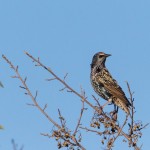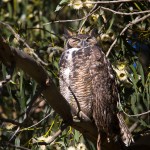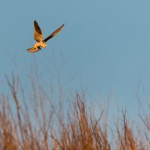Note: this post was published on NextDoor.
**As always in our new normal, please check with local agencies regarding safety alerts and closures. **
WHAT’S IN THE CANYON? We are still in summer birding mode here in the East Bay hills. A glance at the eBird data from the park indicate we may notice some departures of a few species from Wildcat Canyon. By the end of July it will be a lot harder to find Allen’s Hummingbird, Olive-sided Flycatcher, Hooded and Bullock’s Orioles, and Grasshopper Sparrows. I’m not going to put money on whether these are truly gone from the area or just much harder to detect, but from our perspective as birdwatchers it amounts to much the same thing.
July may seem to be peak summer and way too early to be thinking about fall migrants coming through, but that’s not strictly true. Some individuals of northern or montaine (mountain-dwelling) species could turn up. These “early” migrants could be parents who failed to nest successfully and are cutting their losses with an early exit. On the other side of the coin, some species don’t require an extended period of parenting so successful moms and or dads might be able to start their migration before their kids are ready to make the trip. Finally, we could see some movement of birds because of local or regional events like fires, droughts, or extreme heat. We are still learning about these responses. Bird reports from this time of year can help scientists chart and predict how birds react to our frequently-inhospitable western landscapes.
MORE BIRDING RESOURCES. Last month I provided some information on physical field guides and binoculars. This month I’ll add to that some apps and online resources for birds and bird identification.
Apps for Identifying Birds:
Guide apps. Most paper field guides now have mobile app analogs that you can download to your phone. The convenience of this is pretty revolutionary – to have a book, or even a whole library, with you at all times! On my phone I have Sibley, Peterson, and an app-only title called iBird PRO. Audubon is also highly regarded. Most of these aren’t free, so maybe start with one (my favorites is Sibley, possibly for the same reasons I like his real-world guide) and then watch for sales on the other ones.
Aside from convenience, these bird apps have another huge advantage. Along with the photos or illustrations, most also provide a few samples of sound recordings for each species. These may be listed as either songs or calls, with songs usually the more elaborate territorial or mate attraction vocalizations and calls often indicating alarm, anti-predator behavior, contact with conspecifics, begging for food, etc.
A couple of warnings and caveats about the sound recordings: First off, most species have a lot of variation in their sounds and even across several apps you may not capture all of this. Don’t get frustrated if you can’t find the exact sound you are hearing. Secondly, it’s possible that the birds themselves can hear the recordings and react to them. While this can be a handy technique for matching a sound to a species THIS CAN ALSO BE DISRUPTIVE TO THE BIRDS. Imagine some stranger standing outside of your house shouting at you! It’s not that it’s never OK to use audio playbacks, but just be mindful of how you use this tool. Don’t do it to sensitive or threatened species, don’t do it in popular birding spots where the impacts are multiplied, don’t do it when you might be near a nest, and don’t do it more than you absolutely have to.
For more on this and other issues of responsible birding, please check out the American Birding Association statement on birding ethics:
If our first generation of apps are more or less translations of the field guide and birdsong records to the mobile format, the next generation is here and getting better. Check out Merlin, an app from the famous Cornell Laboratory of Ornithology. Merlin makes use of your location to suggest birds you might be seeing. More than that, you can upload photos (and now sounds) that it will try to identify using machine learning. These AI-ID techniques are not perfect – the sound identification in particular is pretty new – but they sometimes get it right or at least might suggest the another part of the avian family tree if you aren’t close to an ID through more traditional means.
Of course you can also crowdsource your questions, either in local birding forums or on sites like Whatbird.com.
Apps for keeping track of your bird sightings:
Most of the field guide apps will let you check off whether you’ve seen a species or not. Here I want to focus on apps where your sightings data can be put to use by scientists.
eBird: this app has a lot of functionality for both reporting birds you’ve seen and finding birds. This is primarily what I use for my hikes in the canyon and more and more for “official” counts such as the Audubon Christmas Bird Count. I’ll direct you to some tips for using the app since I could spend several updates on how best to use it. The one thing that I’ll mention is that there are (volunteer) reviewers who follow up on sightings of unusual or unexpected birds. There is no shame in being asked for more information or being gently corrected by one of these people. It has happened to yours truly. Since your sightings become part of datasets that many scientists depend on, the reviewers provide an important function in quality control.
iNaturalist. This app is hosted by the California Academy of Sciences. This app isn’t strictly for bird sightings. You can enter mammals, plants, insects that you see as well. I’m not quite as familiar with the app as eBird, but my impression is that iNaturalist focuses more on documenting presence using photos or other media and is less expectant that your list is going to include everything you saw (compared with eBird, which puts a premium on completed lists).
Technology to find birds
Gone are the days when you had to dial into a phone recording to hear the latest bird sightings. What are some of the 21st century options to learn what birds are where?
List-serves. This is still a go-to for many people – send your birds by email and receive sightings as they come in or as daily digests. Be sure to understand the rules for each one, they may or may not allow photo attachments, discussion, out-of-area sigtings, etc. The local list for the East Bay is run by Mt. Diablo Audubon and is called ebb-sightings@groups.io
For an overview of all the birding listserves, check out this compiler (California is near the top).
eBird. Wait, didn’t I already talk about eBird for reporting your lists on a hike? Ebird is also a powerful way to keep up with both expected species in a location and specific birds you might be interested in. At eBird .org check out the Explore tab for some of the possibilities. Hotspots are birding locals (like a park, or section of shoreline) — searching through these lets you see what’s been reported at a given location, either scrolling through recent sightings or bar charts of seasonal abundance. This is my main tool for writing these updates about Wildcat Canyon!
Want to know where other people have reported a species you want to see? Use the Species search and you’ll see a map with sightings of that bird flagged for you. You can even set up county-level email alerts to inform you when a new sightings of interest show up.
Social media. Like photos of birds? There are facebook and flickr groups that might be your cup of tea. Birding California gets dozens of posts per day from all over the state, while The San Francisco Bay Area Birding Group is lower traffic but everything you see will be within an hour or so drive. Some locations and parks may have their own small groups as well. As with the listserve, be sure to check out the rules before you post or share content.
This has turned into quite a long post, but I’ve only scratched the surface. Questions? Suggestions for your favorite apps? Let me know!
Good birding!
Alan
alankrakauerphotography.com



